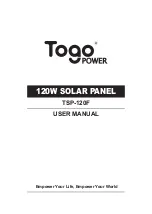
SIM01E-001
4
INSTALLATION MANUAL -PHOTOVOLTAIC MODULES-
1. INSTALLATION
The mounting method has been verified by SHARP and
NOT CERTIFIED by a third party organization. Please
review the descriptions and drawings carefully; not
mounting the modules according to one of these methods
may void your guaranty. (Design load according to
IEC61215 (wind/ snow): 1,600Pa)
Mounting Using Clips: Clamping on Longer Frame (Figure2)
The modules can be mounted using clips (clamps) designed for
solar modules as defined in the following Figures. Note that the
mounting clips should meet the required dimensions as defined in
the Figure1. Note that the CLIP CENTER POSITION (e) is important
as specified in the Figure2. The module must be supported on the
array system and should overlap the array rail by at least 10mm. The
array rails must support the bottom of the frames and must be
continuous piece (no breaks in the rail).
2. ELECTRICAL INSTALLATION INSTRUCTION
Cable characteristics
Conductor size: 4.0mm
2
, Cable type: XLPE cable (H1Z2Z2-K)
Maximum DC voltage: 1.5kV
Ambient temperature: -40°C to +90°C,
Maximum conductor temperature: 120 °C
Module configuration (Recommend)
# Maximum series
configuration: please refer to Table 1
(This value is calculated under the condition of Voc at -
40 °C.)
# Maximum parallel configuration: (Parallel connection of
each string shall be conducted with following two options.
Any other parallel connections are prohibited.)
a) Case of using the diodes; 1 diode per maximum 2
parallel strings (Connect a diode or more in series for
every string or every 2 parallel strings for protection of
module from reverse current over load.)
b) Case of using the fuses; 1 fuse per every string (Connect
a fuse for every single string for protection of module
from reverse current over load.)
Connection cables requirement
The module shall be mated to the same connectors;
Type: C1
Brand: Solargiga Energy Holdings Limited
3. WARNING
Keep all MODULES and electriacal CONNECTORS clean
& dry before installation.
4. Disposal
Dispose
photovoltaic
modules
properly. For Information about the
proper disposal, contact your local
recycling site
ELECTRICAL OUTPUT AND THERMAL CHARACTERISTICS
Rated electrical characteristics of Isc, Voc, are within ±10 percent of the indicated values and +5/-0 percent of Pmax (power
measurement tolerance: ± 3%), under STC (standard test conditions) (irradiance of 1000 W/m
2
, AM 1.5 spectrum, and a cell
temperature of 25 °C (77°F)).
Table-1. Electrical characteristics (at STC)
Model
name
Max imum
Power
(Pmax )
Tolerance
Open-Curcuit
Voltage
(Voc)
Short-Circuit
Current
(Isc)
Voltage at point
of max . Power
(Vmpp)
Current at point
of max . Power
(Impp)
Max imum
system voltage
Over-Current
Protection
Class for protection
against elecrical
shock
Max imum series
configuration(*)
ND-AF330C
330W
+5%/-0%
45.96V
8.91A
39.11V
8.45A
1,500V
15A
Ⅱ
26
* The maximum series number of modules depends on the local conditions. These values are calculated under the condition of Voc at -40 °C.
Under normal conditions, a photovoltaic module is likely to experience conditions that produce more current and/or voltage than
reported at Standard Test Conditions. Accordingly, the values of Isc and Voc marked on this module should be multiplied by a
factor of 1.25 when determining component voltage ratings, conductor capacities, fuse sizes and size of controls connected to the
module output.
The module has been qualified in an environmental temperature range of -40 °C to +40 °C and up to 100% relative humidity as
well as rain, and the altitude up to 2,000m in accordance with IEC61730.
Class for protection against electric shock
This module is classified
as “Class
Ⅱ
” according to IEC61730.
These PV modules are intended for installation where geeral
user access and contact to insulated live parts is anticipated.
FIRE RATING
This module is rated as “Fire safety class C” according to .
IEC61730-2:2004 or UL790
Figure1. Clips (Clamps) requirement
1) Clip: Al alloy, 3.3mm Min. thickness
2) Catch length (38mm Min.)
3) Covering depth (5mm Min. on the frame)
4) Supporting depth (10mm Min.)
5) Frame (applicable to all frame sections)
6) Array rail
(applicable to parallel or crossed mounting)
Figure2. Clamping on longer Frame
300 mm <
e
< 400 mm
e
: span from module corner to clip center
e
e
e
e






















